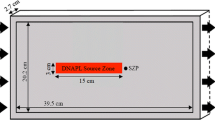Abstract
A mathematical model and an analytical solution are presented to describe field-scale dense non-aqueous phase liquid (DNAPL) source dissolution and source zone biodecay rates coupled with advective–dispersive dissolved plume transport. The model is employed to investigate various source remediation options on source zone mass depletion, net source mass flux, and dissolved plume attenuation for different source zone “architectures” (i.e., pools versus residual DNAPL) and compliance criteria. Remediation options considered include partial source mass removal, source flow reduction, and source zone enhanced biodecay. Partial mass reduction reduces the source zone mass flux and downgradient concentrations for residual DNAPL sources and pools, which can significantly reduce dissolved plume size and time to reach compliance criteria. Source zone flow reduction decreases the rate of source mass depletion, but can facilitate compliance, if concentrations at compliance locations are not too high initially. Increase in source biodecay rate, especially with concomitant increases in dissolution kinetics, can decrease the time to achieve compliance criteria over biodecay alone.
Similar content being viewed by others
References
Brown C.L., Pope G.A., Abriola L.M. and Sephrnoori K. (1994). Simulation of surfactant enhanced aquifer remediation. Water Resour. Res. 30(11): 2959–2977
Dominico P.A. (1987). An analytical model for multidimensional transport of a decaying contaminant species. J. Hydrol. 91: 49–58
EPA, U.S. In-situ thermal oxidative process, U.S.EPA 540-MR-93-524 (1993)
Falta R.W., Lee C.M., Brame S.E., Roedere E., Coats J.T., Wright C., Wood A.L. and Enfield C.G. (1999). Field test of high molecular weight alcohol flushing for subsurface nonaqueous phase liquid. Water Resour. Res. 35(7): 095–2108
Falta R.W., Rao P.S. and Basu N. (2005a). Assessing the impacts of partial mass depletion in DNAPL source zones: I. Analytical modeling of source strength functions and plume response. J. Contam. Hydrol. 78: 259–280
Falta R.W., Rao P.S. and Basu N. (2005b). Assessing the impacts of partial mass depletion in DNAPL source zones: II. Coupling source strength functions to plume evolution. J. Contam. Hydrol. 79: 45–66
Heron G., Christensen T.H., Enfield C.G. and Zutphen M. (1998). Soil heating for enhanced remediation of chlorinated solvents: A laboratory study on resistive heating and vapor extraction in a silty, low-permeable soil contaminated with trichloroethylene. Environ. Sci. Tech. 32(10): 1474–1481
ITRC, Techical and Regulatory Guidance for Surfactant/Cosolvent Flushing of DNAPL Source Zones, http://www.itrcweb.org/Documents//DNAPLs-3.pdf, Interstate Technology Regulatory Council, 56 pp (2003)
Jawitz, J.W., Fure, A.D., Demmy, G.G., Berglund, S., Rao, P.S.C.: Groundwater contaminant flux reduction resulting from nonaqueous phase liquid mass reduction, Water Resour. Res. 41, W10408, doi:10.1029/2004WR003825 (2005)
MacKinnon L.K. and Thomson N.R. (2002). Laboratory-scale in situ chemical oxidation of a perchloroethylene pool using permanganate. J. Contam. Hydrol. 56: 49–74
Mravik S.C., Sillan R.K., Wood A.L. and Sewell G.W. (2003). Field evaluation of the solvent extraction residual biotreatment technology. Environ. Sci. Tech. 37(21): 5040–5049
Park E. and Zhan H. (2001). Analytical solutions of contaminant transport from finite one-, two- and three-dimensional sources in a finite-thickness aquifer. J. Contam. Hydrol. 53: 41–61
Park, E., Parker, J.C.: Effect of partial flow reductions on DNAPL source dissolution rate, abstract submitted for poster presentation, Remediation of Chlorinated and Recalcitrant Compounds, Battelle, Monterey, Calif., May (2004)
Park E. and Parker J.C. (2005). Evaluation of an upscaled model for DNAPL dissolution kinetics in heterogeneous aquifers. Adv. Water Resour. 28: 1280–1291
Parker, J.C., Park, E.: Modeling field-scale dense nonaqueous phase liquid dissolution kinetics in heterogeneous aquifers. Water Resour. Res. 40, W05109, doi:10.1029/2003WR002807 (2004)
Parker J.C., Park, E., Tang, G.: Dissolved plume attenuation with DNAPL source remediation, aqueous decay and volatilization—Analytical solution, model calibration and prediction uncertainty. J. Contam. Hydrol. in review (2007)
Ramsburg C.A., Abriola L.M., Pennell K.D., Loffler F.E., Gamache M., Amos B.K. and Petrovskis E.A. (2004). Stimulated microbial reductive dechlorination following surfactant treatment at the Bachman Road site. Environ. Sci. Tech. 38(22): 5902–5914
Rao, P.S.C., Jawitz, J.W.: Comment on “Steady-state mass transfer from single-component dense non-aqueous phase liquids in uniform flow fields” by T.C. Sale and D. B. McWhorter, Water Resour. Res. 39, 1068, doi:10.1029/2001WR000599(2003)
Sale T.C. and McWhorter D.B. (2001). Steady state mass transfer from single-component dense nonaqueous phase liquids in uniform flow fields. Water Resour. Res. 37(2): 393–404
Semprini L., Hopkins G.D., Roberts P.V. and McCarty P.L. (1992). Pilot scale field studies of in-situ bioremediation of chlorinated solvents. J. Hazardous Mat. 32(2–3): 145–162
Soga K., Page J.W.E. and Illangasekare T.H. (2004). A review of NAPL source zone remediation efficiency and the mass flux approach. J. Hazardous Mat. 110: 13–27
Sorenson, K.S.: Recent progress in biioremediation of chlorinated solvent DNAPL source areas, Partners in Environmental Technology Techniocal Symposium and Workshop, Nov 28–30, 2006, US Dept. of Defense—SERDP, C-46 (2006)
Zhu J. and Sykes J.F. (2004). Simple screening models of NAPL dissolution in the subsurface. J. Contam. Hydrol. 72: 245–258
Author information
Authors and Affiliations
Corresponding author
Rights and permissions
About this article
Cite this article
Park, E., Parker, J.C. Effects of Mass Reduction, Flow Reduction and Enhanced Biodecay of DNAPL Source Zones. Transp Porous Med 73, 95–108 (2008). https://doi.org/10.1007/s11242-007-9164-x
Received:
Accepted:
Published:
Issue Date:
DOI: https://doi.org/10.1007/s11242-007-9164-x



